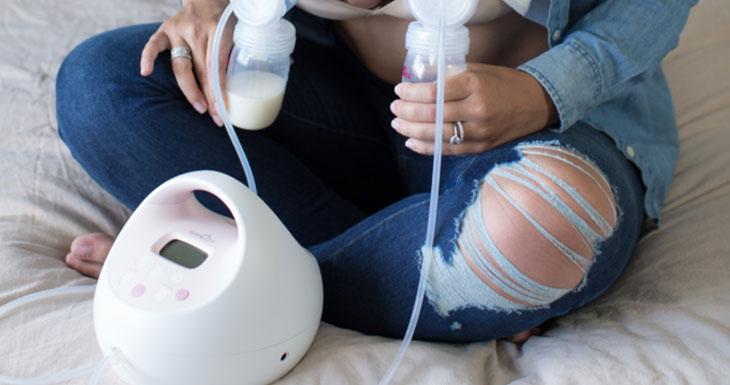The Over Achiever: When one breast produces more than the other

By: Jacque Ordner BSN, RN, IBCLC
Have you noticed that one of your breasts seems to consistently produce more milk? If you’re pumping, this may be even more noticeable. If your baby nurses, you may have noticed that he or she prefers one side or seems to finish nursing on one side much faster than the other. Rest assured, this is normal! One study of exclusively pumping mothers found that in 65.7% of pumping sessions observed, the right breast produced at least slightly more milk. In another similar study, only 2.6% of the exclusively pumping mothers displayed equal pumping output from both breasts.
Why does this happen? So, we know it’s normal for one breast to produce more or to have a greater pumping output, but WHY? Breasts aren’t typically symmetrical. Like many other parts of the human body (eyes, hands, feet, ears, etc.) a degree of asymmetry is normal. This can mean a difference in the amount of milk making tissue (alveoli) or even in the amount and size of milk ducts. Many times, mothers can readily observe a difference in the size of their breasts and also notice that one commonly feels “fuller” than the other. Other less common reasons for this discrepancy include previous breast surgery and previous injury or trauma to the breast. Rarely, asymmetry is caused by a disorder known as Poland Syndrome. This syndrome is evidenced by missing or underdeveloped muscle tissue on only one side of the body and often results in one breast being dramatically smaller and less developed than the other. In general, breast asymmetry is completely normal as is having one breast that produces more milk. We like to call that breast the Over Achiever.
We’ve compiled a few tips to help “even out” milk output:
- If you’re pumping, consider trying different settings to see if each breast responds differently to certain cycles/vacuums. Once you determine which settings are best for each breast, determine a plan to incorporate these settings into your typical pump session. For example, some woman report that one breast responds best to Massage Mode (cycle 70) while the other responds well to an Expression Mode cycle. Moms often have great success with switching between the two modes like the example below:
-5 minutes at cycle 70
-5 minutes at cycle 54
-5 minutes at cycle 70
-5 minutes at cycle 38
*Remember that higher vacuum doesn’t necessarily mean more milk! We never recommend increasing the vacuum to an uncomfortable level.
- Consider adding more stimulation for the lower producing side. If you’re pumping, this can be as simple as starting or ending the pumping session with just a few extra minutes of single pumping on the lower producing side. If you’re nursing, consider starting sessions on the lower producing breast or adding a few minutes of single pumping on that side after nursing.
- Do YOU have a preference? It’s not uncommon for mom to unknowingly develop a preference for feeding from one side over the other. We often prefer to keep our dominant hand free, and therefore may feed more often or spend more time on the opposite side. Keeping a simple log of feeding times for each side can help highlight any preferences you might not have noticed otherwise.
- Encourage better nursing and greater pumping output with your hands! If baby tends to stop nursing on the less preferred side sooner, consider incorporating breast compressions while nursing. This can help keep the flow a bit faster and more interesting for baby. It can also make milk removal easier. Similarly, Hands On Pumping is a technique that can help elevate your lower producer to Over Achiever status. Check out this video from Stanford University: https://med.stanford.edu/newborns/professional-education/breastfeeding/maximizing-milk-production.html
- Add in hand expression. One breast may give less output because it just doesn’t respond to pumping as well as the other. Hand Expression is a technique that can help increase pumping output not only for the lower producing breast, but even for the Over Achiever breast as well! A few ways to incorporate hand expression include in between pumping or nursing sessions, following pumping or nursing sessions, or when you’re running short on time and can’t fit a full pumping session in. Here’s a link for a fantastic resource on the topic: https://med.stanford.edu/newborns/professional-education/breastfeeding/hand-expressing-milk.html
Keep in mind that it is normal for one breast to be the over achiever and it’s absolutely ok if you choose to do nothing to even out the supply. Having a lesser producing breast doesn’t mean there is something wrong, it just means our bodies aren’t perfectly symmetrical! However, if baby consistently fully refuses one breast, if there is a noticeable change in size or shape of only one breast, if there is a lump that doesn’t go away or grows, or if there is a lump that doesn’t move with the breast tissue, reach out to your healthcare provider as soon as possible. Additionally, if baby seems uncomfortable turning toward one breast or always seems to turn his or her head in the same direction, reach out to your pediatrician for further evaluation for conditions such as torticollis. Should you desire to bring both breasts to Over Achiever status, incorporating the tips above is a great place to start!
Keep on keeping on, mamas! We know you’re doing your very best to provide your babies with the best start and we support you! If you have questions about uneven milk supply or any other breastfeeding related topics, we can help! Our International Board Certified Lactation Consultants are available for free consultations at www.spectrababyusa.com/lactationservices. You can also email us at ibclc@spectrababy.com Happy pumping!
References
Engstrom, J. L., Meier, P. P., Jegier, B., Motykowski, J. E., & Zuleger, J. L. (2007). Comparison of Milk Output from the Right and Left Breasts During Simultaneous Pumping in Mothers of Very Low Birthweight Infants. Breastfeeding Medicine, 2(2), 83-91. doi:10.1089/bfm.2006.0019
Hill, P. D., Aldag, J. C., Zinaman, M., & Chatterton, R. T. (2007). Comparison of Milk Output Between Breasts in Pump-Dependent Mothers. Journal of Human Lactation, 23(4), 333-337. doi:10.1177/0890334407307575


